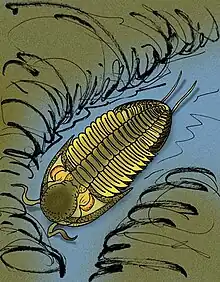Paladin (trilobite)
Paladin is a genus of trilobite which lived 354-259 Ma, during the Late Paleozoic era; more specifically, during the Carboniferous and Permian periods. It was widespread: fossils have been discovered in what are now East Asia, Europe and North America.[2][3][4]
| Paladin Temporal range: Carboniferous – Permian, | |
|---|---|
| Scientific classification | |
| Domain: | Eukaryota |
| Kingdom: | Animalia |
| Phylum: | Arthropoda |
| Class: | †Trilobita |
| Order: | †Proetida |
| Family: | †Proetidae |
| Genus: | †Paladin Weller, 1936[1] |

Artist's reconstruction of P. morrowensis
The genus was erected in 1936 by J. M. Weller.[1] The name derives from the paladins, the semi-legendary twelve foremost knights of Emperor Charlemagne (748-814).
Paladin was a fast-moving low-level epifaunal deposit feeder; that is, it scavenged at the bottom of shallow marine or brackish waters.
Species
Approximately fifty species have been assigned to the genus;[5] the following are accepted:[2]
- P. eichwaldi shunnerensis (King, 1914). 326.4-318.1 Ma, Great Shunner Fell, England. Synonyms Griffithides shunnerensis, P. shunnerensis, Weberides shunnerensis.
- P. helmsensis (Whittington, 1954). 339.4-318.1 Ma, Texas.
- P. iwaizakiensis (Kobayashi and Hamada, 1984). 265.0-259.0 Ma, Japan.
- P. morrowensis (Mather, 1915). 318.1-314.6 Ma, Oklahoma. Synonym Griffithides morrowensis.
- P. mucronatus (Girty, 1910). 339.4-336.0 Ma, Arkansas and Oklahoma. Synonym Griffithides mucronatus.
- P. opisthops (Kobayashi and Hamada, 1979). 314.6-306.95 Ma, Thailand.
- P. veeravurusi (Kobayashi and Hamada, 1979). 314.6-306.95 Ma, Thailand.
References
- Weller, J. M. (1936). "Carboniferous trilobite genera". J. Paleontol. 10 (8): 704–714.
- "Paladin Weller 1936 (trilobite)". Fossilworks.
- "Paladin Weller, 1936". GBIF.
- "Paladin". Mindat.org.
- Brezinski, David R. (2003). "Evolutionary and Biogeographical Implications of Phylogenetic Analysis of the Late Palaeozoic Trilobite Paladin" (PDF). Special Papers in Palaeontology. Palaeontological Association. 70: 363–375.
This article is issued from Wikipedia. The text is licensed under Creative Commons - Attribution - Sharealike. Additional terms may apply for the media files.